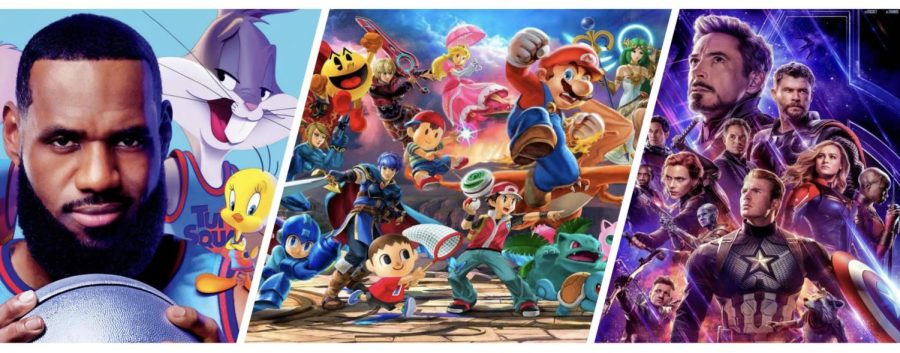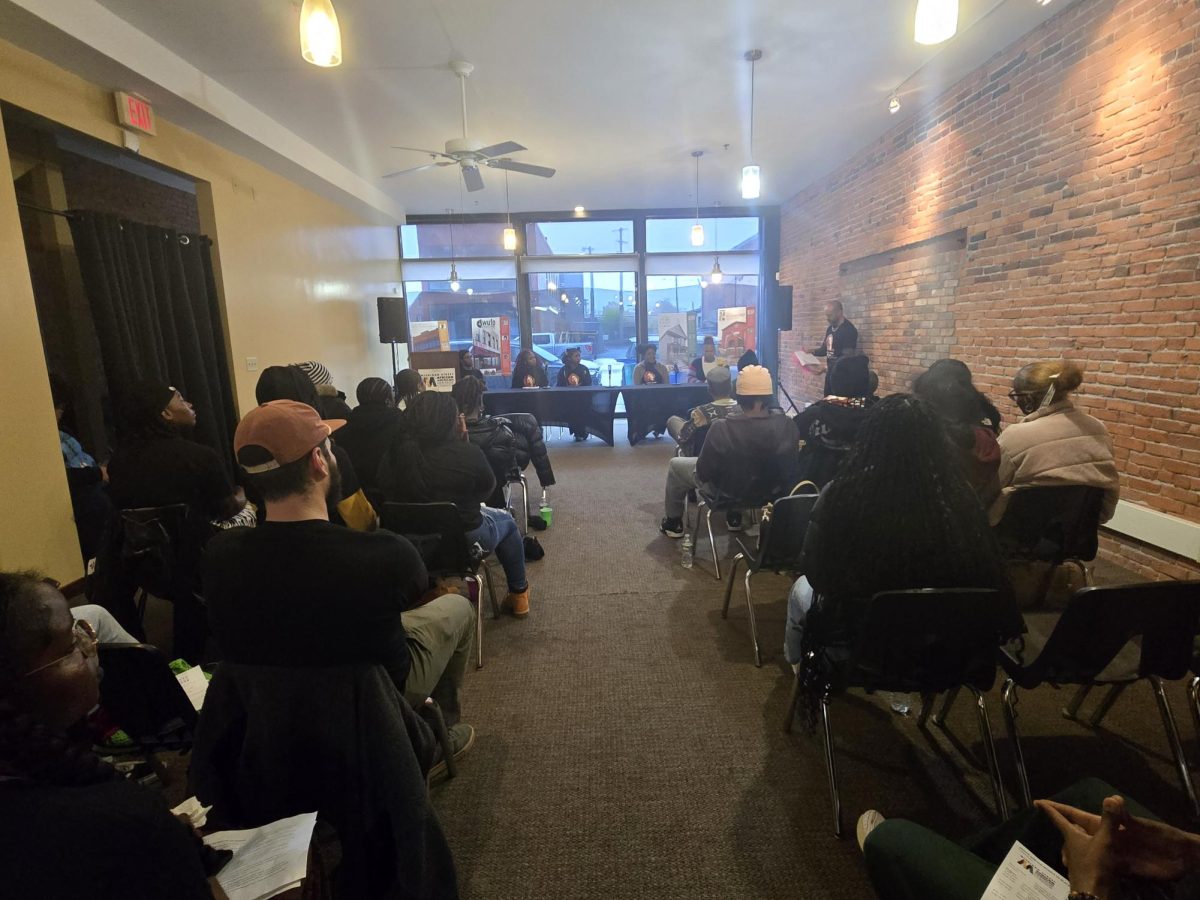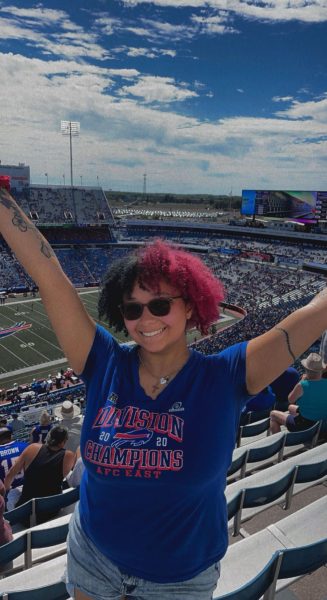Drowning in crossovers: The newest trend in the entertainment industry
November 10, 2021
We’ve reached the end of an era as the final character was recently revealed for the gaming crossover juggernaut, “Super Smash Bros. Ultimate” on October 5.
This final fighter, Sora from the “Kingdom Hearts” games, completes the biggest entry in the series’ 20+ year history. The series has gained popularity for including characters from multiple video game franchises and different gaming companies beyond Nintendo, a sort of celebration of gaming.
Something else also happened on October 5 however, and it’s emblematic of a rapidly growing trend in entertainment media.
“Nickelodeon All-Star Brawl,” a “Smash Bros.” style game, was released on the same day as the big reveal for the final character in “Smash Bros. Ultimate.” This new game follows the same premise as the “Smash Bros.” series, just with Nickelodeon content instead.
Characters from several Nickelodeon shows like “Ren & Stimpy” and “Avatar: The Last Airbender” come together to duke it out in a platform-fighting party game.
Immediately people saw the similarities to the “Smash Bros”. formula and that was no accident by Nickelodeon.
This game was no ‘shot in the dark’ idea by some Nickelodeon representative, it was designed to emulate the success of “Smash Bros.” by using the ‘epic crossover of your favorite characters’ concept. And while fans were quick to catch the parallels between the two games, it only seemed to boost the popularity of the Nickelodeon copycat because it was so much like “Smash Bros.”
The amount of attention the Nickelodeon project received following its reveal was intense. Everyone seemed to be excited and interested in the project’s concept, some even predicted it may steal the spotlight from “Smash Bros.” as the most popular crossover fighting game.
For the purposes of clarity we’re going to define ‘crossover’ as any entertainment project where the main draw is the content and characters coming together from two or more existing properties or franchises.
Now that the we have the general concept down, we’ve all heard of the MCU, right? Marvel Studio’s massively popular interconnected and continuous film franchise spanning 26 movies and counting?
Yeah, that one. The ‘cinematic universe’ concept of the franchise has become increasingly popular due to its capacity for variety in genre, directors, scale and, now with the success of their Disney+ shows, even media format.
It’s an impressive feat to have all of these vastly different stories and characters all existing in this shared world where cameos and big team-up adventures are bound to happen.
Of course other studios took notice of the MCU and its worldwide popularity. It only made sense for Marvels ‘rival’, DC, to try their own take at a cinematic universe for their cast of legacy superheroes, but some other franchises jumping on the trend are…odd.
For example, the 2020 film “Scoob!” is set to kick off a Hanna-Barbera cinematic universe for classic cartoon franchises like the “Flintstones” and “Yogi Bear.”
The most important part of these ‘cinematic universes’ is the crossover aspect (“Star Wars” films don’t fall into this category because they only contain “Star Wars” original content).
People love to see characters that normally wouldn’t interact do just that.
Regardless of what franchises are crossing over with each other and how cool it is, I can’t help but worry that the increasing saturation of crossover events in entertainment is stifling originality in favor of easy profit.
This is already a common issue across the entertainment industry, quantity over quality is just the norm now, but this new trend of simply taking already established and loved series and just mashing them together is an insultingly low bar to meet.
A recent example of this trend guiding the decisions of film production was “Space Jam 2: A New Legacy.”
Now, obviously this is a sequel to an infamously strange and silly crossover between Looney Tunes characters and…the real world? Yet the new spin on the beloved classic seems to lean heavily in to the spectacle of the crossover rather than the interactions between the characters that made the original so charming and funny.
I watched both movies for the first time back to back so I don’t have any nostalgia giving me rose tinted glasses of the original.
The first “Space Jam” is about Michael Jordan being recruited by the “Looney Tunes” characters to foil the villains plans, bonding as Jordan teaches the toons to play basketball and believe in themselves. A very silly movie that doesn’t shy away from the classic slapstick comedy of “Looney Tunes” fame.
“Space Jam 2” has a lot of the same elements. NBA star meets up with “Looney Tunes” crew to play basketball and stop the villain, but I guess the executives decided “Looney Tunes” alone wouldn’t sell tickets this time.
One portion of the film revolves around LeBron James and Bugs Bunny travelling to different Warner Bros. worlds, like Gotham City and the Matrix, and the final act is absolutely drowning in cameos by different Warner Bros. characters in the audience of the basketball game.
Anything and everything that Warner Bros. owns makes an appearance, from “Harry Potter” to “Rick and Morty.” It felt like the company was just flexing their muscles, but at least they were gracious enough to put a little bit of plot in there every few minutes.
The movie was carried by those “Wow, I know that thing!” cameo moments to subsist for the two hour run time.
I can’t say that all crossovers are inherently bland or not entertaining. I would be lying if I didn’t say “Smash Bros.” was one of my favorite game series, but the reason I love it is not just because of the crossover of different games, but the fun game mechanics and gameplay it offers.
The reason I consider a lot of the recent crossover pop-ups to be less original is because rather than focusing on new and unique stories, or gameplay, etc., they rely on the spectacle of the franchises to gain attention for the project.
The MCU isn’t great simply because it includes all of those superheroes, but because they tell compelling and engaging stories with those superheroes.
This new trend isn’t much more than simply the latest method for Hollywood to earn easy money, using existing IP’s to rake in money from those who are already loyal fans without having to put in much effort in creating new ideas.
It’s nothing we haven’t seen before, just that good old corporate greed. There’s going to be a point, if it hasn’t already passed, where people are going to stop caring about the concept of crossovers, and by then Hollywood will have a new tactic up their sleeves to get people in theater seats.
Have you noticed a sudden increase in crossover media?
Do you think it can last or introduce some innovation to become something better in the future?
I personally don’t know where the trend will go but if there is a genuinely good concept for a crossover that is substantial and unique enough, I would love to see it come to fruition.




